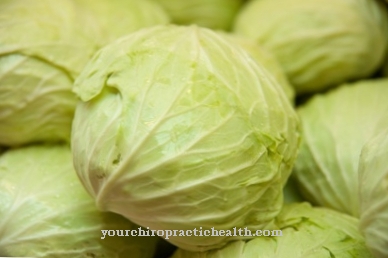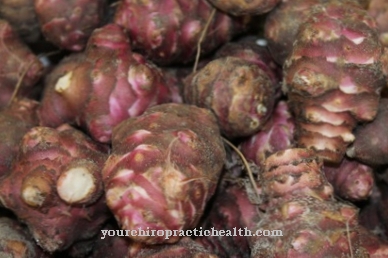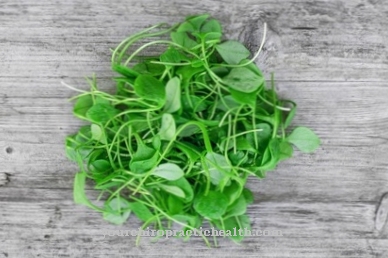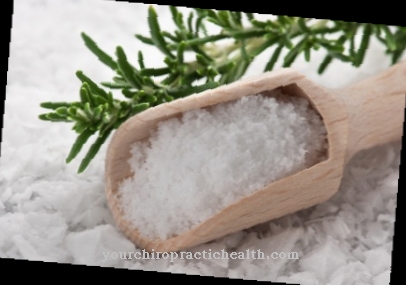Broccoli (Brassica oleracea var. Italica Plenck) is a vegetable from the cruciferous family. The plant, which is related to cauliflower, is rich in minerals, vitamins and phytochemicals.
What you should know about broccoli

The green florets of broccoli are actually not yet fully developed inflorescences. In contrast to cauliflower, the buds of broccoli can be seen very clearly. The heads of the plant are colored blue-green to dark green.
But there are also varieties in which the florets appear purple, yellow or white. The normal growing season for cauliflower is between 14 and 15 weeks. The broccoli florets are harvested when the middle of the flowers is fully developed and still closed. The closed florets are cut off with a 10 to 15 centimeter long piece of the stem and the associated leaves. Further flower heads will grow from the remaining buds on the side, which can then be harvested in due course.
Like all members of the cabbage family, broccoli is derived from wild cabbage. The cabbage family was first mentioned in antiquity. Both the ancient Greeks and the Romans used varieties of leaf cabbage. These included simple types of cauliflower, which must have been very similar to today's broccoli plant. The first broccoli plants probably come from Asia Minor. In Europe, the plant was initially only known in Italy. The Princess of Urbino Caterina de ’Medici first brought broccoli to France in the 16th century. From there it came under the name Italian asparagus also to England.
Broccoli was introduced to the United States in the 18th century by the then US President Thomas Jefferson. At first it was only supposed to serve as a test plant, but quickly found its way onto the American plate.
Today the main growing areas in Europe are in the western Mediterranean countries. The area around the city of Verona in Italy is particularly famous for broccoli growing. Domestic broccoli is available in Germany between June and October.
Importance to health
Broccoli is rich in minerals and vitamins. It is rich in potassium, calcium, iron, phosphorus, zinc and sodium. The calcium content in particular is very high. Broccoli can thus contribute well to covering the daily requirement for the quantity element. The cabbage also contains numerous vitamins from the B group.
These include vitamins B1, B2, B6 and E. Vitamin E, provitamin A and vitamin C are also included. Broccoli has a lot ahead of the cauliflower, especially when it comes to vitamin C content. When prepared gently, broccoli contains almost twice as much vitamin C as cauliflower.
In addition to minerals and vitamins, broccoli also contains secondary plant substances. Secondary plant substances are also called phytamines. They are usually used by plants to ward off predators, but they have great health benefits for humans. The secondary plant substances in broccoli include flavonoids and glucosinolates. Glucosinolates can store indoles and isothiocyanates. The most important isothiocyanate in broccoli is sulforaphane.
It also contains the isothiocyanates 3-butenyl isothiocyanate, 4-methylsulfinylbutyl isothiocyanate, allyl isothiocyanate and methylsulfinylpropyl isothiocyanate. Broccoli is also high in protein and complex carbohydrates. In contrast, it hardly contains any calories or fat. 100 grams of broccoli has only 24 kilocalories. For every 100 grams there are 3.8 grams of protein and 2.7 grams of carbohydrates. The fat content is only 0.2 grams per 100 grams. With a water content of 89 percent and a fiber content of 3 percent, broccoli is ideal for weight loss.
Ingredients & nutritional values
| Nutritional information | Amount per 100 gram |
| Calories 34 | Fat content 0.4 g |
| cholesterol 0 mg | sodium 33 mg |
| potassium 316 mg | carbohydrates 7 g |
| protein 2.8 g | vitamin C 89.2 mg |
Broccoli not only provides the body with essential vitamins and minerals, it is also said to protect against cancer. The secondary plant substance sulforaphane is responsible for this effect. Sulforaphane causes the body to produce indole-3-carbinol (IC3). The active ingredients from broccoli have proven to be effective in fighting tumor stem cells. These tumor stem cells usually do not respond well to chemotherapy.
However, new tumor tissue continues to form from them, so that the cancer cannot be cured without combating the tumor stem cells. The ingredients of broccoli block a special signaling pathway in the particularly aggressive cancer cells and thus fight against resistance to chemotherapeutic agents. In experiments with mice it could be shown that chemotherapy in combination with sulforaphane completely stops tumor growth.
Metastasis to other organs can also be prevented by the active ingredient from broccoli. Further studies are currently being carried out to prove that the anti-carcinogenic effects of broccoli can also be transferred to humans. To treat cancer, however, sulforaphane must be extracted from broccoli and given in freeze-dried powder form.
Intolerances & allergies
Allergic reactions to cabbage vegetables are very rare. Only contact allergic reactions have been described in connection with broccoli. Broccoli oil and broccoli extract are used in some cosmetics. Intolerances to cabbage vegetables and thus also to broccoli are more common. Many people react to cabbage with stomach discomfort and gas. Broccoli is usually very well tolerated by people with a histamine intolerance.
Shopping & kitchen tips
Broccoli is in season in Germany between June and October. The fresher the broccoli, the more vitamins, minerals and phytochemicals it contains. When buying, you should make sure that the florets are deep green and not wilted. The head of cabbage should be compact when purchased. The inflorescences should be tight and not open. Under no circumstances should the florets be yellow.
As broccoli can still bloom after harvest, it should be stored in a cool and dark place until eaten. The cabbage keeps best when wrapped in cling film in the vegetable drawer. Since broccoli wilts quickly, it should be consumed as quickly as possible. Broccoli florets should not be stored with ethylene-producing fruits such as apples or bananas. The broccoli will then spoil much faster.
Broccoli can also be frozen. Before freezing, however, it should be blanched for three minutes. Packed in airtight freezer bags, it can be kept in the freezer for up to 10 months.
Preparation tips
Before cooking, the florets should be cut from the stalk. All florets should be roughly the same size so that they are cooked at the same time. The stalk itself can also be consumed. However, it must first be freed from its woody bark. The small florets and the peeled stalk should now be peeled thoroughly. The broccoli can then be eaten raw or briefly blanched. After blanching, the cabbage must be quenched with ice water, otherwise it will continue to cook. The longer the broccoli is cooked, the more nutrients it loses.



























